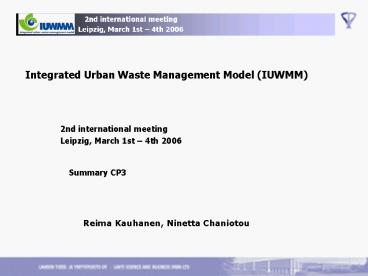INTEGRATED URBAN WASTE MANAGEMENT - PowerPoint PPT Presentation
1 / 18
Title: INTEGRATED URBAN WASTE MANAGEMENT
1
Integrated Urban Waste Management Model (IUWMM)
2nd international meeting Leipzig, March 1st
4th 2006
Summary CP3
Reima Kauhanen, Ninetta Chaniotou
2
Contents of this presentation
- Review of project approach
- CP3 outputs
- Inputs as precondition to CP3
- Overview of CP3 report
- Interregional comparison
- Discussion on the criteria of comparison
- Typology of criteria of comparison
- Performance measures, EU
- Performance measures, OECD
- Terminology clarification
- Performance measures, OECD EU
- EU policy aspects relevant to IUWMM
- Conclusions
3
Review project approach
CP 3
CP 4
CP 5
CP2
Collection of information from the regions
synthetic report
- Identification of international best practices
- Agreement on optimum integarted waste mangement
model
IUWMM Model
Regional action plans
Project handbook
Handbook 1
Handbook 2
Memorandum of understanding
Partners common regional points
Political visions
Platform
Closing conference
Study tours
4
CP3 outputs
- Handbook "Towards the formulation of optimum
mSW-management models"- 10 Regional action plans
for MSW management- 3 Agendas for 1st, 2nd and
3rd workshops- 3 Minutes from 1st, 2nd, and 3rd
workshops- 1 Policy Forum- 1 MoU "Towards an EU
MSW-management forum" endorsed - 1 Excerpt of
minutes from ISC meeting month 21- 3 6-month
Component 3 reports
5
Input as precondition to CP 3
Terminology clarification field of focus of the
joint development
Clarification of the criteria for identifying
best practices according to the 6 key parametres
CP 3
CP2
Model for describing optimiseable IUWMM
6
Overview of CP 3 report
- 1. Input from the partners
- Bologna, Portugal, Krakow, Norfolk, Portugal,
Talinn, Thessaloniki, Yamboll - Lahti and West Saxony not totally ready yet
- 2. Rationale
- Comparative approach
- Conclusions in relation to
- CP2 model
- EU policies
- 3. Objectives
- Interregional comparison, with the purpose to
link regional contexts with state of the art
solutions in the context of EU policies and
eventually reqiest fundign for the implementation
of these solutions.? - MoU
- Regional action plans
7
Interregional comparison
- Harmonisation
- Amount
- Streams
- Integrated waste life cycle
- Product and process design
- End of life measures
- Active prevention measures
- Organisation of the collection and routing
- Critical mass of waste? collectivity
- ? recycling targets?
- ? environmental targets?
- ? ?
8
Discussion on the criteria of comparison
- Harmonisation
- National legislation
- Does national legislation create solutions?
- Regional basic figures area, population, density
- To what extent urban waste is a real issue
- Per capita urban waste
- How and how much people consume
- Urban waste composition and quantity
- Composting? Energy recovety? Re-use? Recycling?
- Urban waste management practices, and good
practices - Stakeholders
- Performance measurements
- Per capita (GDP/waste)
9
Typology of criteria of comparison
Stakeholders
Optimal
Scenery
- Performance measures
- Policy (EU)
- Implementation (local, i.e. not horizontal)
10
Performance measures
- Old and new waste management hierarchy in the
EU
11
Performance measures
Waste minimisation vs waste prevention
accoring to the OECD
12
Terminology clarification
- Strict avoidance Complete prevention of waste
generation by virtual elimination of hazardous
substances, or reduce material or energy
intensity in production, consumption, and
distribution () - Reduction at source Minimisation of toxic or
harmful substances and / or minimisation of
material () or energy consumption. - Product re-use Mulitple use of a product in its
original form, for its original purpose or for an
alternative, with or without reconditioning - Market necessary
- Definition necessary
13
(No Transcript)
14
EU policy aspects relevant to IUWMM
- Recycling mixed blessing
- EU policy
- Waste as life cycle vs waste to dispose of ()
- ENERGY
- End of life products ()
- Product and process design measures ()
- Two sides,
- Impact on the environment ()
- Profitability (energy recovery) ()?
Measurement amount of (embedded energy /weight
of waste)population - Overall performance measurement the rate (per
capita GDP / per capita waste) increasing over
time (decoupling growth from environmental
impact) - Definition what is really waste (the use of by
products characterised as waste is hindered by
European environmental legislation)
15
Conclusions
- Stakeholders
- Attitude to waste life cycle, disposal
- Who is involved, how
- Legislation leading to solutions
- Who pays, when, and why
Optimal
- Scenery
- Amount
- Streams
- Performance measures
- Policy (EU)
- Implementation (local)
- Reduction at source separation, at least 3, bio,
energy, hazardous - Pre-treatement management (process)
- Treatement management (technology)
16
Conclusions
Impact
Amount
Proposal focus on energy recovery
Profitability
Source
Citizens participation
Separation
Unit
Technology
Collection
Pre-treatement management
Routing
Payment
17
Conclusions
What is waste
Definitions
Recycling
Re-use
Energy recovery
Product and process design
Waste reduction
End of life measures
18
First conclusions for the action plans
- Habit enforcement (citizens participation)
- Spatial organisation of waste collection
- Documentation for decision making
- Financing organisation of waste management































